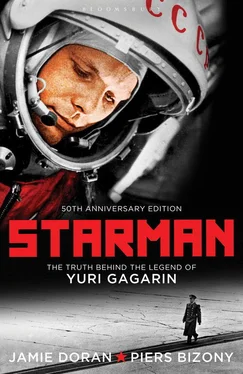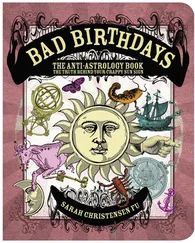American Intelligence experts knew perfectly well that preparations for Vostok’s launch were under way. Washington time was eight hours behind Baikonur’s. While the cosmonauts were resting on their wired-up mattresses, President Kennedy appeared on an NBC early-evening television programme sponsored by Crest toothpaste. He and his wife Jacqueline talked with reporters Sander Vanocur and Ray Scherer about the difficulties of raising their small children, and about the president’s ‘hands-on’ management style. Kennedy mentioned that political events often appeared more subtle and complex from inside the Oval Office than they did to the outside world. Even as he smiled and joked for the television cameras, he knew that a significant defeat awaited him in just a few hours’ time. [8] Murray, Charles & Bly Cox, Catherine, Apollo: The Race to the Moon , London: Secker & Warburg, 1989, p. 76.
At 5.30 a.m. on April 12, Korolev and Yazdovsky breezed into the cosmonauts’ darkened room, all hale and hearty, and turned on the lights. ‘What’s this, my dears? A lie-in?’ Gagarin and Titov went through the motions of awakening from a deep and untroubled slumber.
‘How did you sleep?’ the doctors asked.
‘As you taught us,’ Gagarin answered warily.
Korolev went off to check his rocket, but after Gagarin and Titov had washed and shaved, he rejoined them in the day-room for a simple breakfast of concentrated calories and vitamins in the appetizing form of a dark brown paste. Even in Gagarin’s heavily censored published account of that day, The Road to the Stars , Korolev’s exhaustion is evident:
The Chief Designer came in, and it was the first time I’d ever seen him looking careworn and tired. Clearly he’d had a sleepless night. I wanted to give him a hug, just as if he were my father. He gave us some useful advice about the coming flight, and it seemed to me that talking to us cosmonauts cheered him up a bit. [9] Gagarin, The Road to the Stars , quoted in Golovanov, Our Gagarin , p. 125.
The doctors arrived from another building across the road to give the cosmonauts a final check-up, bringing with them more of their favourite things: a clutch of sticky, round sensor pads. Titov and Gagarin stood there patiently, half-naked, while the pads were glued into place on their torsos. Star City’s director Yevgeny Karpov gave them each a bouquet of flowers to cheer them up. Actually he was passing them on from the old woman, Klavdiya Akimovna, who usually lived in the cottage. He could not let her in just now, which was probably just as well, for she had a touching story about her son, who was a pilot just like Yuri, but who had been killed in the war. No need to mention that, she said. Karpov ushered her away with a few kind words and took the flowers into the cosmonauts’ room. He wanted to say something important, something meaningful on this great occasion, but could not think of anything sensible. ‘Instead of advice and farewells, all I could do was joke and tell funny stories and other pieces of nonsense, just like everyone else. At the breakfast table we squeezed space-food out of tubes and pretended we thought it was amazingly delicious.’ [10] Golovanov, Our Gagarin , p. 123.
After breakfast, when the doctors had finished with their pads and glue, the cosmonauts were driven across to the main spacecraft assembly building. The huge construction floor for the Vostok was empty. The rocket and capsule were already out at the pad, but in a closed-off side facility there remained some small but essential items of equipment still to prepare – the spacesuits.
So far, Titov and Gagarin had been treated exactly alike. Now, in the clean white glare of the suiting-up room, a subtle shift of emphasis came into play. Titov was the first to receive his padded undergarment; the first to climb into his pressure-suit; the first into the bright orange outer layer. By the time he was fully dressed in his suit, Gagarin was barely ready. Titov knew not to become excited about this. The technicians had dressed him first, and Yuri second, so that the First Cosmonaut would spend less time between here and the launch pad overheating in his suit. During the drive to the gantry both their suits were ventilated, rather ineffectively, by plug-in fan boxes inside the crew bus. Just in case something happened, Titov had to be ready. A little warmer in his suit than Yuri perhaps, but ready just the same. For now, he knew that getting dressed first meant that he would almost certainly stay second.
Gagarin had his own shock of realization to deal with. In his official account of the flight, The Road to the Stars , he wrote, ‘The people helping me into my spacesuit held out pieces of paper. One even held out his workpass, asking for an autograph. I couldn’t refuse, and signed several times.’ Yevgeny Karpov watched Gagarin right up to the last moment. He noticed the First Cosmonaut’s anxiety about all these autographs. ‘For the first time since his arrival at Baikonur he was at a loss, unable to give his usual instant replies to people. He asked, “Is this really necessary?” I said, “You’d better get used to it, Yura. After your flight you’ll be signing a million of these things.”’ With many months of technical and physical training behind him, Gagarin had not had much time to consider what might happen when he came back to earth after today’s mission. Now, almost too late, he caught a glimpse of the enormous social burden that would be placed on his shoulders.
Dressed in the twentieth century’s most distinctive suits of armour, Gagarin and Titov took their seats in the bus: a matching pair of cosmonauts, the same sort of age, at the same peak of physical fitness, with the same hard slog of medical endurance and procedural training behind them. Their spacesuits and helmets were identical. It could be either one of them going up today, but by some ridiculous anomaly of fate it was going to be Gagarin. When the bus drew up alongside the base of the launch gantry, Titov wished him good luck, and meant it. Cameraman Vladimir Suvorov recalled the scene in his diary:
According to our old Russian tradition, on these occasions one should kiss the person going away three times on alternate cheeks. It is completely impossible to do this while wearing bulky space suits with helmets attached, so they simply clanged against each other with their helmets, and it looked very funny… Then Gagarin got off the bus and paced awkwardly towards the Chief Designer. Obviously it wasn’t easy for him to walk in his clumsy suit. [11] Suvorov & Sabelnikov, The First Manned Spaceflight , p. 62.
Titov remained in his seat in the bus, staring listlessly through the windows at the reinforced concrete control bunker – at the ‘hedgehogs’. That’s what everybody called them: the array of jagged spars sticking out of the roof at crazy angles. The theory was that if a misfiring rocket fell on top of the bunker and exploded, the hedgehogs would break it up before it could actually smash into the roof. The worst of the blast would be deflected, and the people in the bunker might live to launch another day. At least the hedgehogs made more sense than this business of sitting in the bus as Gagarin’s back-up. Titov recalls his thoughts that day with painful clarity. ‘We’d trained together a long time. We were both fighter pilots, so we understood each other. He was commanding the flight, and I was his back-up, just in case. But we both knew “just in case” wasn’t going to happen. What could happen at this late stage? Was he going to catch flu between the bus and the launch gantry? Break his leg? It was all nonsense. We shouldn’t have gone out to the launch pad together. Only one of us should have gone.’
Читать дальше












